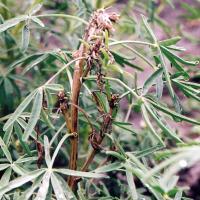Contributing factors
The extent of BYMV spread in crops depends on many factors. The most important include:
- Rainfall events in late summer and early autumn are associated with greater spread of BYMV. This is because rainfall stimulates plant growth before the crop growing season and provides hosts (clovers, weeds and volunteer crop plants) that encourage rapid aphid multiplication and BYMV spread in clover plants.
- Time of aphid arrival. Early aphid arrival favours earlier and more extensive spread and greater yield losses.
- The source of the virus. As spread declines rapidly over distance, infected pastures adjacent to crops are much more important sources than infected pastures further away.
- If abundant clover weeds remain uncontrolled within the crop, they may result in greater spread than external sources.
- Abundance of colonising and non-colonising aphids during the growing season. This increases BYMV spread in the crop.
- Other factors include: lack of groundcover, sparse stands, poor canopy development, heavy grazing of nearby pasture, paddocks with large perimeter to area ratios, and extended growing seasons.









